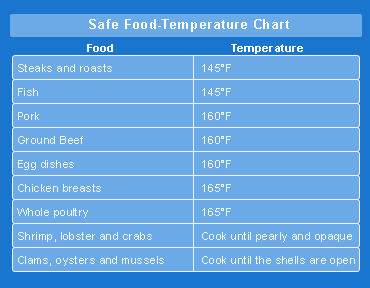
When cooking, wash your hands and cooking/preparation surfaces often. To ensure cleanliness, wash hands for 20 seconds with soap and warm running water. Wash surfaces and utensils after each use, and wash fruits and veggies even if you are going to peel them. Don’t use soap or detergent.
To ensure you don’t cross-contaminate use separate cutting boards and plates for produce and for meat, poultry, seafood and eggs. An easy way to remember this is to use separate, color-coded cutting boards for different ingredients.
Also, keep meat, poultry, seafood and eggs separate from all other foods in your grocery cart AND in your refrigerator.
COOK
Make sure you cook to the right temperature. Use a food thermometer to ensure foods reach an appropriate cooking temperature, and keep food hot after cooking (140 ˚F or above). Also, make sure you microwave food thoroughly (to 165 ˚F)
Before cooking, never thaw or marinate foods on the counter. Instead, put them in the refrigerator … it’s warm enough to thaw, but cool enough to inhibit bacterial growth Refrigerate uneaten food promptly. Perishable foods should be refrigerated within two hours, and make sure you know when to throw food out. Find storage times for food in the refrigerator and freezer here.
Other things to remember when cooking are don’t put cooked meat back on a plate that held raw food. Don’t let food cool before putting it back into the fridge – the cooling time outside of the refrigerator can allow bacterial growth. When cleaning with bleach, use 1 teaspoon of bleach per quart of water.
Signs and symptoms of foodborne illness include vomiting, diarrhea, abdominal pain, fever and chills. If you or someone you know suspect a foodborne illness, rest and drink plenty of fluids and do not use anti-diarrheal medication, as it may slow elimination of bacteria from your system. Foodborne illness usually resolves on its own within 48 hours. If symptoms last longer or if blood appears in your stool, contact your healthcare provider.
If you are interested in learning more about specific food safety methods in your home or tactics for healthier eating in general, contact the VA to set up an appointment one-on-one with a Registered Dietitian. If you’re interested in weight management/healthy living, the MOVE weight management program may be for you. Ask your primary care provider today if you want to get involved.
Loren Bruce is from Memphis, TN and is a dietetic intern at the Memphis VA Medical Center. She completed her Bachelor of Science in Nutrition at Mississippi State University and is currently working on her Master of Science in Health Promotion.
Topics in this story
More Stories
Summer can be a joyful time of year, but some outdoor activities can be hard for some Veterans. In this guest post, former VA Secretary Bob McDonald shares resources and plans to navigate summer activities.
"A CAPITOL FOURTH" airs on PBS Thursday, July 4, 2024 from 8:00 to 9:30 p.m. E.T.
The following is an account from Army Veteran Robert Pryor on how he was able to find and reconnect with the pilot who saved his life in Vietnam.









